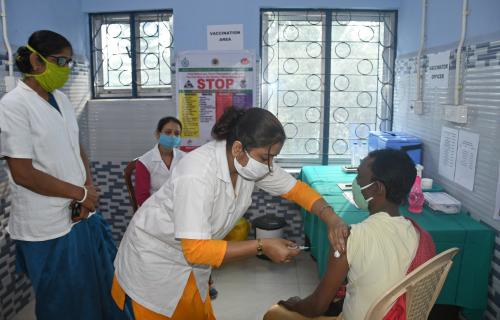Overweight and obesity—A growing challenge in Saudi Arabia
Overweight and obesity, referring to body mass index (BMI) over 25 and 30, respectively, are a growing global epidemic and one of the key public health challenges today. Most of the world’s population lives in countries where overweight and obesity have a bigger impact on mortality and disability than underweight. The Sustainable Development Goal 2 (SDG2) proposes the elimination of all forms of malnutrition in children under five, including wasting and overweight. The share of children who are overweight is one of the few SDG indicators that has become worse since 2015, especially in countries such as Saudi Arabia.
The rise of overweight and obesity has been particularly alarming in Saudi Arabia—The rate has nearly doubled over the past 50 years. Like in many other Gulf Cooperation Council countries, rapid economic development and urbanization have brought lifestyle changes including decreased physical activity and increased consumption of highly processed foods and beverages. As a result, more than 50 percent of the population in Saudi Arabia today is overweight (Figure 1), and more than 20 percent have obesity.
Children and adolescents are hit particularly hard
While overweight and obesity rates in Saudi Arabia are high across all age groups, they are increasing rapidly among children and adolescents. The crude prevalence of overweight/obesity among those 5 to 19 years of age is one of the highest in the world at 36 percent, twice the global average in 2016. While overweight and obesity are historically higher among adult women than men in Saudi Arabia, there is a reversal in trend among children and adolescents, with boys now having higher overweight and obesity rates than girls (Figure 2).
Figure 1. Proportion of the population who is overweight in the Gulf Region countries
Source: WHO, 2019
Figure 2. Crude prevalence of overweight and obesity among Saudi Arabian children and adolescents, ages 10 to 19 years, by sex
Source: WHO, 2020
The high rate of overweight and obesity in children and adolescents is especially concerning given that a third of Saudi Arabia’s population is under the age of 15, two-thirds are under 35, and the prevalence of overweight and obesity and the resulting complications will likely increase further as the population ages, if no action is taken. Affected children and adolescents often carry the extra weight into adulthood, leading to lifelong health problems. They are at higher risk of early onset health problems, including type 2 diabetes, high blood pressure, and sleep disorders. It might also impact their psychological well-being by generating low self-esteem, depression, and social isolation.
The heavy burden of overweight and obesity—an unaffordable cost
Overweight and obesity are among the most significant determinants for non-communicable diseases (NCDs) such as heart disease, stroke, type 2 diabetes, and certain types of cancer and have recently been associated with worse outcomes in COVID-19. In Saudi Arabia, overweight and obesity account for 27 percent of all NCD mortality and 15 percent of NCD-related disability in the kingdom.
Overweight and obesity are costing the government around $3.8 billion in direct costs, equal to 4.3 percent of health expenses in the kingdom in 2019. The treatment of type 2 diabetes is a big driver of direct overweight/obesity-attributable costs. Around 7 million Saudis (24 percent) are diabetic, while almost 3 million have prediabetes. This is high compared to a global diabetes prevalence estimated to be around 9 percent in 2019.
Overweight and obesity also have substantial indirect economic implications and costs. They negatively impact human capital—the knowledge, skills, and health that people accumulate to realize their full potential as productive members of society and contribute toward economic growth. A recent study estimated overweight and obesity-attributable absenteeism (absent from work) and presenteeism (working while sick) to cost Saudi Arabia a total of $15.5 billion, equal to 0.9 percent of gross domestic product (GDP) in 2019.
How Saudi Arabia is fighting back
Under its “Vision 2030,” Saudi Arabia is aiming for a 3 percent reduction in obesity and a 10 percent decrease in diabetes prevalence by 2030. Accordingly, Saudi Arabia aims to be at the forefront of implementing interventions to address the main behavioral risk factors of obesity, such as unhealthy diets and inadequate physical activity. It has already commenced by being one of the few countries that mandated menu calorie labeling in all food service establishments, in an effort to help consumers make healthier choices. It also implemented a 50 percent tax on sugar-sweetened beverages and a 100 percent tax on energy drinks in 2017 which already led to a 35 percent decline in carbonated drinks sales. Additionally, it introduced several voluntary and mandatory measures to encourage companies to reformulate their food and beverage products to have less salt, fat, and sugar.
Interventions to target children are now also being prioritized. Saudi Arabia allowed physical education in schools for girls for the first time in 2018 and introduced a promising obesity prevention program for school children called “Rashaqa” which aims to improve nutritional behavior, increase physical activity, and provide preventive and therapeutic services to overweight and obese students or select primary and secondary schools across Saudi Arabia.
Planning for more is in the works. Additional measures currently under consideration include adopting a nutrient profiling model as a general guideline for nutrition-related policies including front-of-package labeling such as nutrition warnings or traffic light labels. The aim is to be at the forefront globally of tackling obesity by 2030 and mitigate the high health and economic burden before it gets worse.
Conclusion
Addressing the overweight and obesity epidemic is critical to achieving the health and economic goals outlined in Saudi Arabia’s “Vision 2030”. It is also critical to achieving several of the SGDs targets, especially targets 2.2 on reducing the prevalence of malnutrition among children under five years of age and 3.4 on reducing premature mortality from non-communicable diseases. Effectiveness and success will require continued targeting of interventions across the life course of the population continued prioritization of prevention over treatment; a commitment and mechanism to work across sectors, and a particular emphasis on implementation, monitoring, and evaluation. If successful, Saudi Arabia has the potential to substantially improve overall health, reduce the NCD burden and preserve Saudi Arabia’s next generation’s human capital.
The Brookings Institution is committed to quality, independence, and impact.
We are supported by a diverse array of funders. In line with our values and policies, each Brookings publication represents the sole views of its author(s).














Commentary
Countdown to 2030: Addressing the stubborn obesity challenge in Saudi Arabia
December 15, 2022